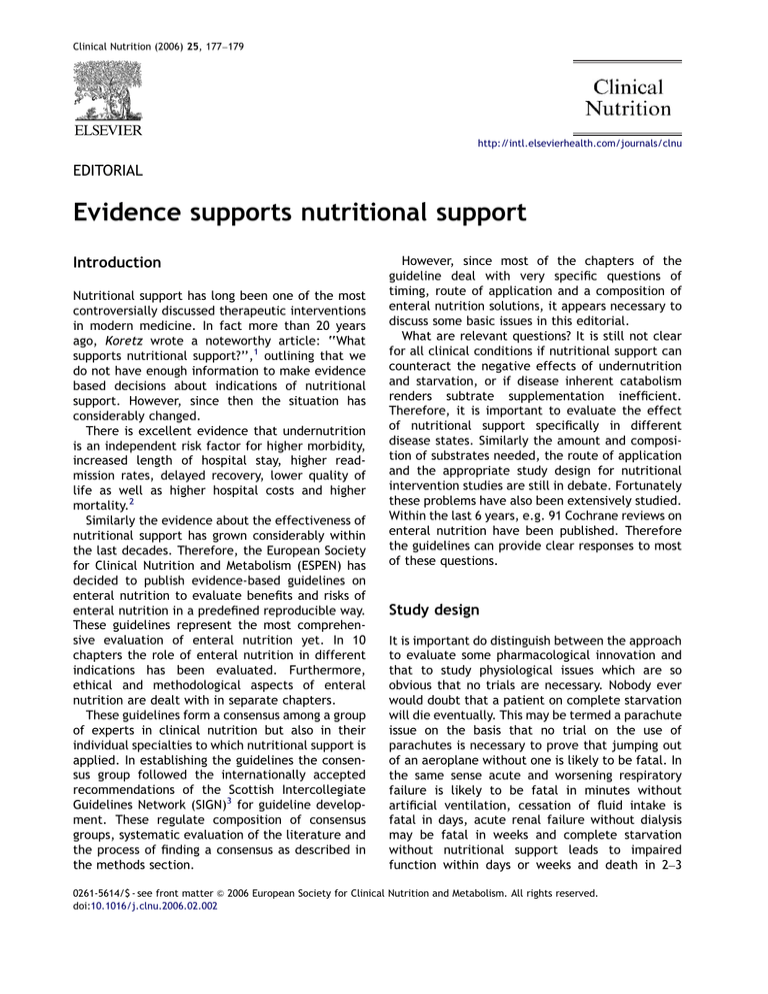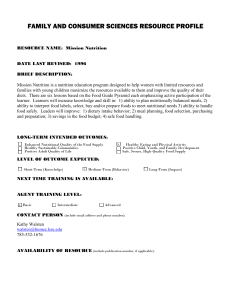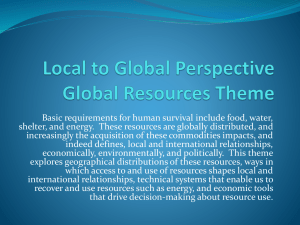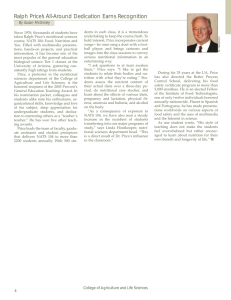
ARTICLE IN PRESS
Clinical Nutrition (2006) 25, 177–179
http://intl.elsevierhealth.com/journals/clnu
EDITORIAL
Evidence supports nutritional support
Introduction
Nutritional support has long been one of the most
controversially discussed therapeutic interventions
in modern medicine. In fact more than 20 years
ago, Koretz wrote a noteworthy article: ‘‘What
supports nutritional support?’’,1 outlining that we
do not have enough information to make evidence
based decisions about indications of nutritional
support. However, since then the situation has
considerably changed.
There is excellent evidence that undernutrition
is an independent risk factor for higher morbidity,
increased length of hospital stay, higher readmission rates, delayed recovery, lower quality of
life as well as higher hospital costs and higher
mortality.2
Similarly the evidence about the effectiveness of
nutritional support has grown considerably within
the last decades. Therefore, the European Society
for Clinical Nutrition and Metabolism (ESPEN) has
decided to publish evidence-based guidelines on
enteral nutrition to evaluate benefits and risks of
enteral nutrition in a predefined reproducible way.
These guidelines represent the most comprehensive evaluation of enteral nutrition yet. In 10
chapters the role of enteral nutrition in different
indications has been evaluated. Furthermore,
ethical and methodological aspects of enteral
nutrition are dealt with in separate chapters.
These guidelines form a consensus among a group
of experts in clinical nutrition but also in their
individual specialties to which nutritional support is
applied. In establishing the guidelines the consensus group followed the internationally accepted
recommendations of the Scottish Intercollegiate
Guidelines Network (SIGN)3 for guideline development. These regulate composition of consensus
groups, systematic evaluation of the literature and
the process of finding a consensus as described in
the methods section.
However, since most of the chapters of the
guideline deal with very specific questions of
timing, route of application and a composition of
enteral nutrition solutions, it appears necessary to
discuss some basic issues in this editorial.
What are relevant questions? It is still not clear
for all clinical conditions if nutritional support can
counteract the negative effects of undernutrition
and starvation, or if disease inherent catabolism
renders subtrate supplementation inefficient.
Therefore, it is important to evaluate the effect
of nutritional support specifically in different
disease states. Similarly the amount and composition of substrates needed, the route of application
and the appropriate study design for nutritional
intervention studies are still in debate. Fortunately
these problems have also been extensively studied.
Within the last 6 years, e.g. 91 Cochrane reviews on
enteral nutrition have been published. Therefore
the guidelines can provide clear responses to most
of these questions.
Study design
It is important do distinguish between the approach
to evaluate some pharmacological innovation and
that to study physiological issues which are so
obvious that no trials are necessary. Nobody ever
would doubt that a patient on complete starvation
will die eventually. This may be termed a parachute
issue on the basis that no trial on the use of
parachutes is necessary to prove that jumping out
of an aeroplane without one is likely to be fatal. In
the same sense acute and worsening respiratory
failure is likely to be fatal in minutes without
artificial ventilation, cessation of fluid intake is
fatal in days, acute renal failure without dialysis
may be fatal in weeks and complete starvation
without nutritional support leads to impaired
function within days or weeks and death in 2–3
0261-5614/$ - see front matter & 2006 European Society for Clinical Nutrition and Metabolism. All rights reserved.
doi:10.1016/j.clnu.2006.02.002
ARTICLE IN PRESS
178
months even in a healthy person.4 No controlled
trial of artificial ventilation, dialysis or fluids has
been undertaken for obvious reasons in patients
with respiratory failure or renal failure respectively
and it therefore seems rather silly to expect a
treatment of prolonged starvation to be tested in
this way. It is inherently obvious for example, that
the alternative to tube feeding in complete
dysphagia or to parenteral nutrition in prolonged
gastrointestinal failure is death within a finite time.
Besides the fact, that the consequences of
starvation are obvious as outlined above, it is
almost impossible to perform blinded studies of
nutritional support versus no nutritional support
due to obvious reasons. It is therefore not a
scientific question if nutritional support is necessary in starvation but rather to which degree may a
patient be starved without increasing his risk or
what is an adequate balance between the risks of
artificial nutrition and the risks of starvation.
Relevant endpoints for nutritional
support
The choice of appropriate endpoints by which to
judge the efficacy of nutritional support needs to
be considered carefully and separately for each
clinical condition, for example: in a condition with
a low mortality, such as colorectal surgery or one
with a high mortality in which 95% of the mortality
risk relates to the disease and other coincident
pathology, the use of mortality as the sole endpoint
of nutritional support may be unhelpful or misleading. It may be more appropriate to use other
parameters such as complication rates, use of
antibiotics, time on the ventilator, length of stay
or time to rehabilitation, in other words—does the
patient get better more quickly with less consumption of resources. For most therapies this is well
accepted, e.g. quality of life or reduction of fatigue
is an accepted endpoint for chemotherapy and
lower cost with similar efficacy is an important
endpoint for many drug studies. For nutritional
support the validity of these endpoints was long
dismissed as soft or surrogate endpoints. This may
be due to the fact, that everybody considered it
logical, that a well-nourished person feels better
than a starving person. However to achieve this in
disease states needs the therapeutic intervention
of nutritional support.
Relevant question and endpoints are therefore:
How can clinically relevant undernutrition be
diagnosed?
EDITORIAL
Does nutritional support improve nutritional
status in a specific situation?
Does nutritional support affect prognosis in a
specific situation?
Do short periods of starvation (i.e.o7 days)
matter in terms of outcome?
What is the preferred feeding method in a given
situation?
What is the most appropriate enteral or parental
formula, composition and amount for each
condition?
Does feeding beneficially affect or alternatively
exacerbate the underlying pathological process?
Evidence-based benefits of nutritional
support
While the authors of each section have examined
the evidence in their respective specialties, the
general evidence concerning the benefits of oral
nutritional supplements (ONS) and enteral tube
feeding have been comprehensively and systematically reviewed by Stratton, Green, and Elia in a
recent publication.2 In 7–11 RCTs of ONS reviewed,
they found a reduction in mortality (26% vs. 17%),
reduced complications (27% vs. 12%), and reduced
length of stay (28 vs. 19 days). In patient groups
without significant prior undernutrition, i.e. with a
BMI420 kg/m2, mortality was not significantly
reduced (20% vs. 19%), but complications were
reduced in three trials (27% vs. 12%), and length of
stay was reduced (16 vs. 12 days).
In 12 RCT’s (600 patients) of enteral tube
feeding, mortality was reduced (23% vs. 11%), in
17 RCT’s (749 patients) total complication rates
were reduced (48% vs. 33%) and in 9 RCTS (442
patients) infective complications were reduced
(46% vs. 23%). Improved outcome was correlated
with adequate nutritional intake and weight gain.
The general indication and effectiveness of ONS
and enteral tube feeding in patients who cannot
fullfil their substrate needs adequately is therefore
well established and the whole consensus group
strongly agreed on this.
Although, as the authors of the various sections
conclude, results may vary according to diagnosis,
prior nutritional status, age, the technical adequacy of treatment, and patient selection.
In some areas, evidence for specific questions
like timing and composition of enteral nutrition is
still lacking upon which to make level A recommendations and much practice, as in other areas of
medicine, is guided by level C evidence. Further
studies are clearly required in these areas.
ARTICLE IN PRESS
EDITORIAL
Integration of nutritional support in the
therapeutic strategy
Although nutritional support is therapy in most
cases it is exactly what it says—supportive rather
than specific treatment of the underlying disease.
It prevents the deleterious effects of starvation
while the underlying condition resolves naturally or
in response to treatment. It is therefore, only one
facet of overall management and needs to be
integrated properly into it. Shortcomings in other
aspects of care may negate any benefits of
nutritional support, similarly inappropriate, unbalanced, unskilled, or excessive feeding may interfere with other aspects of treatment and render
them less effective. Similarly the technical interventions associated with enteral tube feeding have
their own risks, which must be weighed, in each
case, against the expected benefits. Such risks are
minimised when treatment is carried out by expert
staff. Conversely other treatments e.g. drugs may
impair appetite, G.I. function and nutritional
status.
Conclusion
It should therefore be clear, that nutritional
support is indispensable for patients not fulfilling
their energy and substrate needs. These guidelines
do provide evidence-based information about specific problems like timing, dosing, composition and
route of application. They also show where additional studies are needed and under which conditions limitation or withdrawal of nutritional support
like other therapies might be adequate.
The preparation and publication of ESPEN guidelines on enteral nutrition were exclusively funded
179
by ESPEN. The dissemination of the guidelines will
be opened to sponsoring to facilitate access to the
largest possible audience.
References
1. Koretz RL. What supports nutritional support? Dig Dis
1984;29:577–88.
2. Stratton RJ, Green CJ, Elia M. Disease-related malnutrition:
an evidence-based approach to treatment. CAB International
2003.
3. Scottish Intercollegiate Guidelines Network. SIGN 50: A guideline developers handbook. Edinburgh; SIGN: 2004-http://
www.sign.ac.uk/guidelines/fulltext/50/index.html (last accessed Feb 3rd 2006).
4. Keys A, Brozek J, et al. The biology of human starvation
(Minnesota study). Minneapolis: Minnesota Press; 1950.
H. Lochs, C. Pichard, S.P. Allison
Steering Committee for the ESPEN Guidelines on
Enteral Nutrition
H. Lochs
Department of Gastroenterology, Hepatology and
Endocrinology, Charité Universitätsmedizin Berlin,
Schumannstraße 20/21, D-10117 Berlin, Germany
C. Pichard
Clinical Nutrition Unit, Department of Internal
Medicine, Geneva University Hospital, Geneva,
Switzerland
S.P. Allison
Department of Diabetes Endocrinology and Nutrition, Queen’s Medical Center, Nottingham, UK



